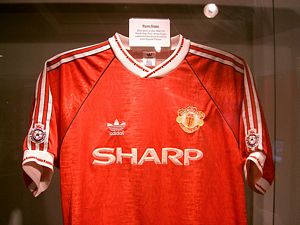















Random Lugnuts: NASCAR Teams and Sponsorship Money |
|---|
 Topics: NASCAR What is Random Lugnuts? It's random bits of stock car racing commentary written on an irregular basis by an irregular racing fan. The name is a reference to the lugnuts that go flying off a car during a pit stop: you never know where they are going to go, what they're going to do when they get there, they can be annoying, they're often useless after a race, and every once in a while someone gets hit and they don't know exactly where it came from.
Topics: NASCAR What is Random Lugnuts? It's random bits of stock car racing commentary written on an irregular basis by an irregular racing fan. The name is a reference to the lugnuts that go flying off a car during a pit stop: you never know where they are going to go, what they're going to do when they get there, they can be annoying, they're often useless after a race, and every once in a while someone gets hit and they don't know exactly where it came from.
Opinions expressed by Bill Crittenden are not official policies or positions of The Crittenden Automotive Library. You can read more about the Library's goals, mission, policies, and operations on the About Us page.
|
Bill Crittenden
September 18, 2009
As much as NASCAR and its teams are criticized for sticking brand logos across every available square inch of everything they bring to the track, the economics of the sport require individual teams to find sponsorship to compete. It's not just the raw costs of running a car and a team that requires such sponsorship, not when the New York Yankees have a payroll of just over $208 million (ESPN.com). A fifth of a billion dollars would buy a lot of NASCAR-spec Impalas, a lot of wind tunnel time, pay for thousands of hours of team labor and still have enough money left over to hire a good driver, and the Yankees haven't had to replace the famed NY on their caps with a corporate logo to sign A-Rod's checks. Why is NASCAR different? Why is it that we can associate Amp with Dale Jr. and Aflac with Carl Edwards but many casual fans might not even recognize the logos of Hendrick Motorsports or Roush-Fenway Racing?
Think about this: in most other sports, each team has a home stadium where they sell tickets to the games. In NASCAR, nobody has a home field, and ticket money isn't collected by the individual teams. The Yankees have Yankee Stadium, whereas NASCAR teams run every race as an "away game." Prize money might cover the basic costs of running a race car, as shown by the start-and-park crowd, and you see how competitive they are. They don't even try to finish races, let alone try to win them. It takes a lot more money to actually compete in the series. Merchandise sales, while a big business to stock car racing fans, doesn't cover the difference between showing up and taking home trophies. Without the money from big corporate sponsors, NASCAR would be very, very different.
Sponsorships, to a stock car team, are about more than covering payroll. Why do teams feel the need to sell every available flat space on every team-owned object they bring to the track? Because sponsorship affects how a team operates on the track. When extra money can buy new testing equipment, or wind tunnel time, or be used to hire better engine builders, the competition for sponsorship money becomes part of the overall competition that is NASCAR racing. Increasing a primary sponsor's return on investment (to keep them signing on year after year) by finding new places to plaster their logo or increasing overall income by selling new spaces to new associate sponsors is just another thing a team can do to find a competitive edge on the other teams.
Thankfully, NASCAR has ensured that the race for money does not win races on the track all by itself, as evidenced by the wide variety of winners we've seen over the years. Otherwise, NASCAR might resemble Formula 1 of years past. While there's no shortage of sponsorship money available in Formula 1, the technology-dependent series rewards those capable of expensive research and development, and so the few teams with the most money have the best technology, the best cars, and can use those to draw the best talent, and with all three dominate the series, resulting in only two or three competitive teams and the championship often decided between the two drivers of the top team. When Brad Keselowski drove James Finch's car to victory at Talladega, followed up by David Reutimann's win for Michael Waltrip Racing, each beating so many teams with so many more resources, they proved that money alone can't ensure victory in NASCAR's top series.
Money certainly can help build a team, though, and the open availability of the corporate sponsorship ensures that almost anyone with talent can get the cash to build a winning racing program. Many of the top NASCAR team owners, such as Rick Hendrick or Roger Penske, came into the sport with their own money from the outside and used that to build their teams. But drivers, relying on sponsorship money given to them by corporations who wanted to associate themselves with top talent and believed in their knowledge of the sport helped drivers such as Michael Waltrip, Dale Earnhardt and now Tony Stewart put winning cars out on the track as owners.
What would happen if the supply of sponsors were dramatically reduced, or if sponsors were somehow discouraged from spending on the sport? After all, as I've mentioned, the start-and-park crowd can run a team on prize money, so why can't everybody else? What would happen is a few wealthy owners who can build better teams without big sponsorships would dominate the sport. The three or four recognizeable personalities would pull in the few funding sources available while the rest just go without. The top drivers would prefer to drive for a well-run and well-funded team, and given their choice sponsors will put their money on winning cars and winning drivers. The end result is the vast majority of money, talent, and sponsors concentrated in the hands of a few teams, reducing the level of competition to the point that few fans are still interested.
Once corporate sponsorships fled CART, the end of the series was a story of domination by a few teams that could still find funding, and Newman-Haas driver Sebastien Bourdais won the championship four times in a row from 2004-2007, and 8 of the 14 Grands Prix held the final 2007 season. Imagine most of the current NASCAR teams operating as two-car or single-car shadows of their current selves because they can't find proper funding for their current operations while one or two fully-funded teams operate as they do today. Think of what would happen if one driver not only won three championships in a row but four and possibly then a fifth (Bourdais and Newman-Haas were only prevented from a fifth by the IRL-CART merger), while also winning twenty-plus races a year for a half decade, and you can imagine what would happen to the fan base of NASCAR. Tired of Jimmie Johnson now? Imagine giving him a fourth championship and tripling his win total over the past three and two-thirds seasons and you have some idea of what the ChampCar World Series had happen to it...and why CART folded.
Big money sponsorship is an essential part of NASCAR. I believe it has helped the sport more than it has hurt it, and there's no way to get it back out without damaging the kind of racing that has built the sport into one of the most watched competitions in America. So it's just something to live with, and I'm sure by now most of us are quite used to it. I'll be "living with it" in a t-shirt with the logos of Amp and National Guard...which has something to do with the subject of part 2 in this series.
One thing NASCAR fans might find interesting is that in other places in the world sponsor logos take precedence over team logos, even for teams as traditional and wealthy as old Manchester United...
 |  |
| Ted Musgrave in 2008 at Milwaukee Note how much bigger the primary sponsor's logo is than the one for HT Motorsports, his team, which is just above and to the right of the Team ASE logo. Photo ©2008 Bill Crittenden View photo, 137KB |
Manchester United Jersey Note how much bigger the Sharp logo is than the Manchester United crest and the similarity in arrangement to Ted Musgrave's firesuit. Photo by Edwin.11 Licensed under Creative Commons Attribution 2.0 Generic License. View photo, 102KB |
